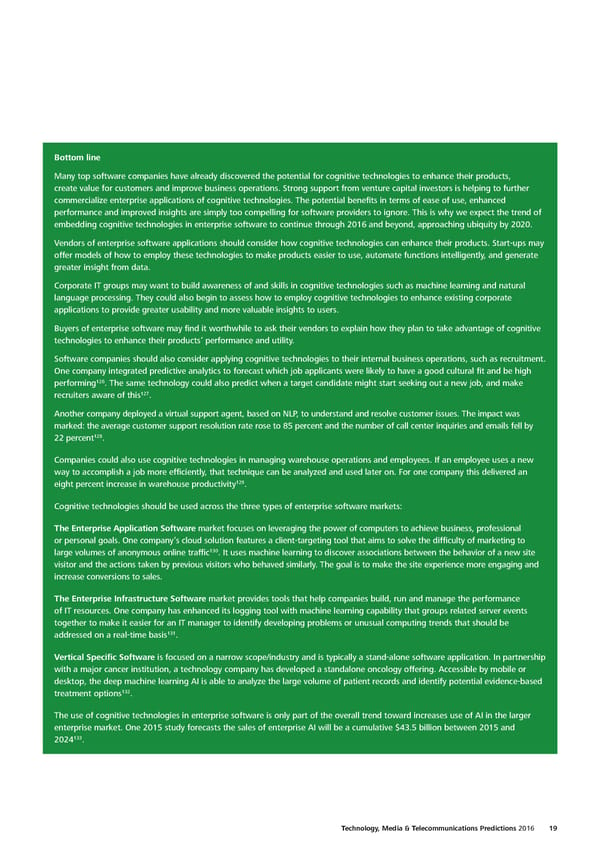Bottom line Many top software companies have already discovered the potential for cognitive technologies to enhance their products, create value for customers and improve business operations. Strong support from venture capital investors is helping to further commercialize enterprise applications of cognitive technologies. The potential benefits in terms of ease of use, enhanced performance and improved insights are simply too compelling for software providers to ignore. This is why we expect the trend of embedding cognitive technologies in enterprise software to continue through 2016 and beyond, approaching ubiquity by 2020. Vendors of enterprise software applications should consider how cognitive technologies can enhance their products. Start-ups may offer models of how to employ these technologies to make products easier to use, automate functions intelligently, and generate greater insight from data. Corporate IT groups may want to build awareness of and skills in cognitive technologies such as machine learning and natural language processing. They could also begin to assess how to employ cognitive technologies to enhance existing corporate applications to provide greater usability and more valuable insights to users. Buyers of enterprise software may find it worthwhile to ask their vendors to explain how they plan to take advantage of cognitive technologies to enhance their products’ performance and utility. Software companies should also consider applying cognitive technologies to their internal business operations, such as recruitment. One company integrated predictive analytics to forecast which job applicants were likely to have a good cultural fit and be high 126 performing . The same technology could also predict when a target candidate might start seeking out a new job, and make 127 recruiters aware of this . Another company deployed a virtual support agent, based on NLP, to understand and resolve customer issues. The impact was marked: the average customer support resolution rate rose to 85 percent and the number of call center inquiries and emails fell by 128 22 percent . Companies could also use cognitive technologies in managing warehouse operations and employees. If an employee uses a new way to accomplish a job more efficiently, that technique can be analyzed and used later on. For one company this delivered an 129 eight percent increase in warehouse productivity . Cognitive technologies should be used across the three types of enterprise software markets: The Enterprise Application Software market focuses on leveraging the power of computers to achieve business, professional or personal goals. One company’s cloud solution features a client-targeting tool that aims to solve the difficulty of marketing to 130 large volumes of anonymous online traffic . It uses machine learning to discover associations between the behavior of a new site visitor and the actions taken by previous visitors who behaved similarly. The goal is to make the site experience more engaging and increase conversions to sales. The Enterprise Infrastructure Software market provides tools that help companies build, run and manage the performance of IT resources. One company has enhanced its logging tool with machine learning capability that groups related server events together to make it easier for an IT manager to identify developing problems or unusual computing trends that should be 131 addressed on a real-time basis . Vertical Specific Software is focused on a narrow scope/industry and is typically a stand-alone software application. In partnership with a major cancer institution, a technology company has developed a standalone oncology offering. Accessible by mobile or desktop, the deep machine learning AI is able to analyze the large volume of patient records and identify potential evidence-based 132 treatment options . The use of cognitive technologies in enterprise software is only part of the overall trend toward increases use of AI in the larger enterprise market. One 2015 study forecasts the sales of enterprise AI will be a cumulative $43.5 billion between 2015 and 133 2024 . Technology, Media & Telecommunications Predictions 2016 19
 Technology, Media & Telecommunications Predictions Page 23 Page 25
Technology, Media & Telecommunications Predictions Page 23 Page 25